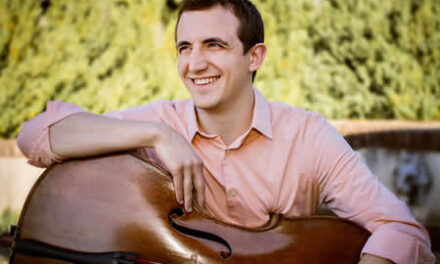The latest from the Greensboro Symphony Orchestra featured music from the early 19th and 20th centuries written by two Germans and a Russian. On tap: Carl Maria von Weber’s Fantasia and Rondo for Clarinet and Orchestra, Ludwig van Beethoven’s Triple Concerto, and Serge Rachmaninoff’s Second Symphony.
The highlight of the evening was the symphony by Rachmaninoff (1873-1943). The arch-romantic Russian wrote the work in 1907, and the premiere took place in St. Petersburg with the composer as conductor. The four-movement symphony is a massive composition, clocking in at close to an hour in duration, a test of endurance for all involved – musicians, conductor, and the audience.
GSO Music Director Dmitry Sitkovetsky explained from the podium that the piece could have been called the “Resurrection” symphony, as it represented a rebirth for Rachmaninoff, whose first symphony was an utter disaster. It was also fitting that it was being performed the very evening that GSO violinists Fabrice and Ewa Dharamraj‘s son was born earlier in the day.
The brooding, ominous introduction contains many of the motives that are used in the rest of the symphony. This lengthy passage moves directly into the Allegro moderato, a long movement marked by swirling string passages and powerful brass that brings about crying climaxes. Sitkovetsky seemed particularly invested in leading the work, often seeming like a sorcerer stirring up a seething orchestra.
Allegro molto, the Scherzo movement, is placed second. A galloping horn theme sets the movement in motion, and the entire brass section played like gangbusters.
The heart of the symphony lies in the glorious Adagio third movement. Remember the theme to Fantasy Island? This is where that soaring tune comes from. Kelly Burke superbly played the extended solo clarinet passage, an important element in the proceedings.
Energy and good spirits infuse the final Allegro vivace. Themes from the other movements return, but they never derail the momentum. The entire symphony comes to a glorious and boisterous conclusion.
All sections of the orchestra seemed to really enjoy sinking their teeth into this rich music, and inspired playing was the result – solid brass, colorful winds, prominent percussion, and strong strings. Kudos to every player and to the conductor, who evoked such passionate playing.
The evening began with music from Weber’s Clarinet Quintet, Op. 34 (1811). Gustave Longenus (1883-1957), a Belgian clarinetist, arranged the quintet for piano and clarinet and the second and last movements became the Fantasia and Rondo in an arrangement for clarinet and string orchestra. In the GSO performance, principal clarinetist Kelly Burke was the soloist.
The Fantasia movement features long-breathed lines and explored the full range of the clarinet. Burke’s playing revealed lots of color and considerable virtuoso technique. The Rondo was one of those “off to the races” movements, with lots of oomph. The ten-minute work was a good audience warm-up piece.
The Hermitage Piano Trio – Misha Keylin, violin, Sergey Antonov, cello, and Ilya Kazantsev, piano – joined the GSO for Beethoven’s Concerto for Violin, Cello, and Piano in C major, Op. 56 (1803). This blend of piano trio and concerto is a curious, somewhat marginal work, although a perennial audience favorite.
The opening Allegro begins with a lengthy orchestra introduction before the soloists enter, one after another. The cello initiates the sequence and is clearly the lead instrument in the concerto; the violin and piano follow. Cellist Antonov, who played Tchaikovsky’s Rococo Variations with the GSO a few years back, is an especially strong player. Perfect intonation and dramatic flair marked his playing throughout. Violinist Keylin provided a contrasting timbre, and pianist Kazantsev filled out the trio. In typical Beethoven fashion, the gentle opening eventually ignites some fireworks.
The beautiful Largo is begun by the cello; eventually all forces join in the eloquent musing. The final Rondo alla Polacca is a vital movement, full of dance rhythms and scurrying up and down scale passages. The three soloists were great fun to watch – in part of course because Beethoven set up the great dialogue and in part because the trio had such fun throwing the melodic morsels back and forth.












